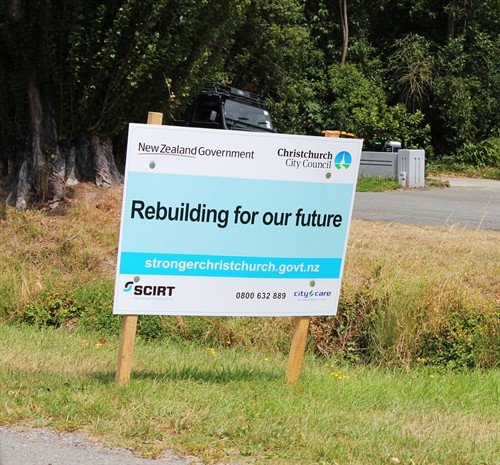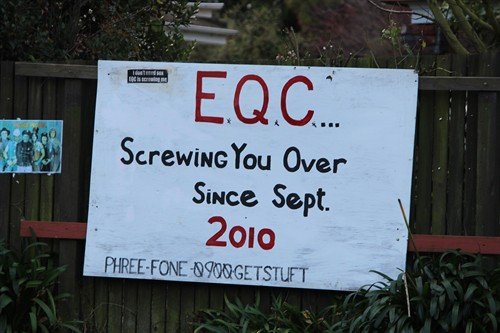Working Towards an Empowered Christchurch
Early on during the response phase to the 22 February 2011 earthquake, John Key famously decreed, “No one will be worse off as a result of these quakes.” For many residents of Christchurch and greater Canterbury this brought on a sigh of relief, but many others were sceptical: could the government really afford to repair the damages to the over 100,000 damaged buildings? And what did “worse off” really mean? As of 31 March 2016, EQC states that 98.9% of home repairs have been completed and that 99% of claims have been settled (http://www.eqc.govt.nz). As of 22 April 2016, SCIRT gauges that 88% of the repairs to the wastewater, storm water, fresh water, and roading in Canterbury have been completed (http://strongerchristchurch.govt.nz).
Paul Corliss
Creative Commons Attribution NonCommercial 3.0.
However, some have criticised these figures, claiming that the work that EQC is doing is shoddy and below code and that many of their complaints are six months to several years old (http://www.stuff.co.nz). In April 2014, a survey by the New Zealand Council for Infrastructure Development (NZCID) showed that major banks, construction companies, and engineering firms believed that CERA and the Christchurch City Council were holding back the rebuild (http://www.rebuildchristchurch.co.nz). For many homeowners, the decisions made by those in charge of the rebuild have left them frustrated and confused. Some have lost faith that their EQC and insurance claims will ever be resolved.
Paul Corliss
Creative Commons Attribution NonCommercial 3.0.
In 2013 South Brighton resident, Hugo Kristinsson created the community group, Empowered Christchurch, in the hopes of helping residents that have lost faith in the system. With the tagline, “Knowledge is power & together we are strong”, Empowered Christchurch aims to document, communicate and address issues relating to the recovery in the Canterbury rebuild; to empower residents; and to protect democracy in Christchurch. It achieves this through communicating with the authorities on behalf of communities; making submissions on legislations and bylaws; distributing information to residents through their newsletter, website, and Facebook page; and organising petitions and protests.
For some time now, CEISMIC has been documenting the work and experiences of Empowered Christchurch. This has been a difficult process, as much of the material is bound by copyright or other restrictions. However, we are excited to announce that today, a collection of newsletters, letters, campaign documents, and meeting minutes is available to be viewed.
According to Hugo, he started Empowered Christchurch after he “realised that long-term sustainability [in Christchurch] was being sacrificed for short-term political interest, and [that] genuine community voices were being systematically silenced.” Particular areas that Empowered Christchurch has focussed on are the flood and liquefaction risk to properties in low-lying and coastal areas, the reduction of protection for residents with TC3 properties under new Building Act laws, and the need for rebuild agencies and their decision processes to be transparent and democratic. This is evident in the letters and OIA requests they sent to key ministers and government agencies involved in the Canterbury rebuild, in their newsletters, and their meetings with the MBIE.
In 2013, Hugo also ran for Mayor during the Christchurch Local Body Elections, in association with Empowered Christchurch. His profile statement, media release, and open letter to the Christchurch public can be found alongside the other Empowered Christchurch material in CEISMIC. Hugo explained to CEISMIC that his decision to run for mayor was not made alone, but with a group of people who were organising events with them at the time. He told us that he, “took on the challenge for the group. I wanted the land issues to be addressed and the vulnerable taken care of. I wanted people to know how the recovery was being planned and essentially [to] highlight how some people were being made more vulnerable through the actions and policies of the authorities.”
Since Empowered Christchurch was created, Hugo and the rest of the members have been active participants in the debates around the Christchurch rebuild. Most recently Hugo attended the Seismics in the City conference on behalf of the organisation and on 21 February 2016 (one day before the fifth anniversary of the 22 February 2011 earthquake), Empowered Christchurch held a successful protest in Cathedral Square for residents still waiting for their EQC or insurance pay-outs. Only time will tell if their hard work and dedication has paid off, but for now they provide a vital voice for Christchurch’s most vulnerable residents.


